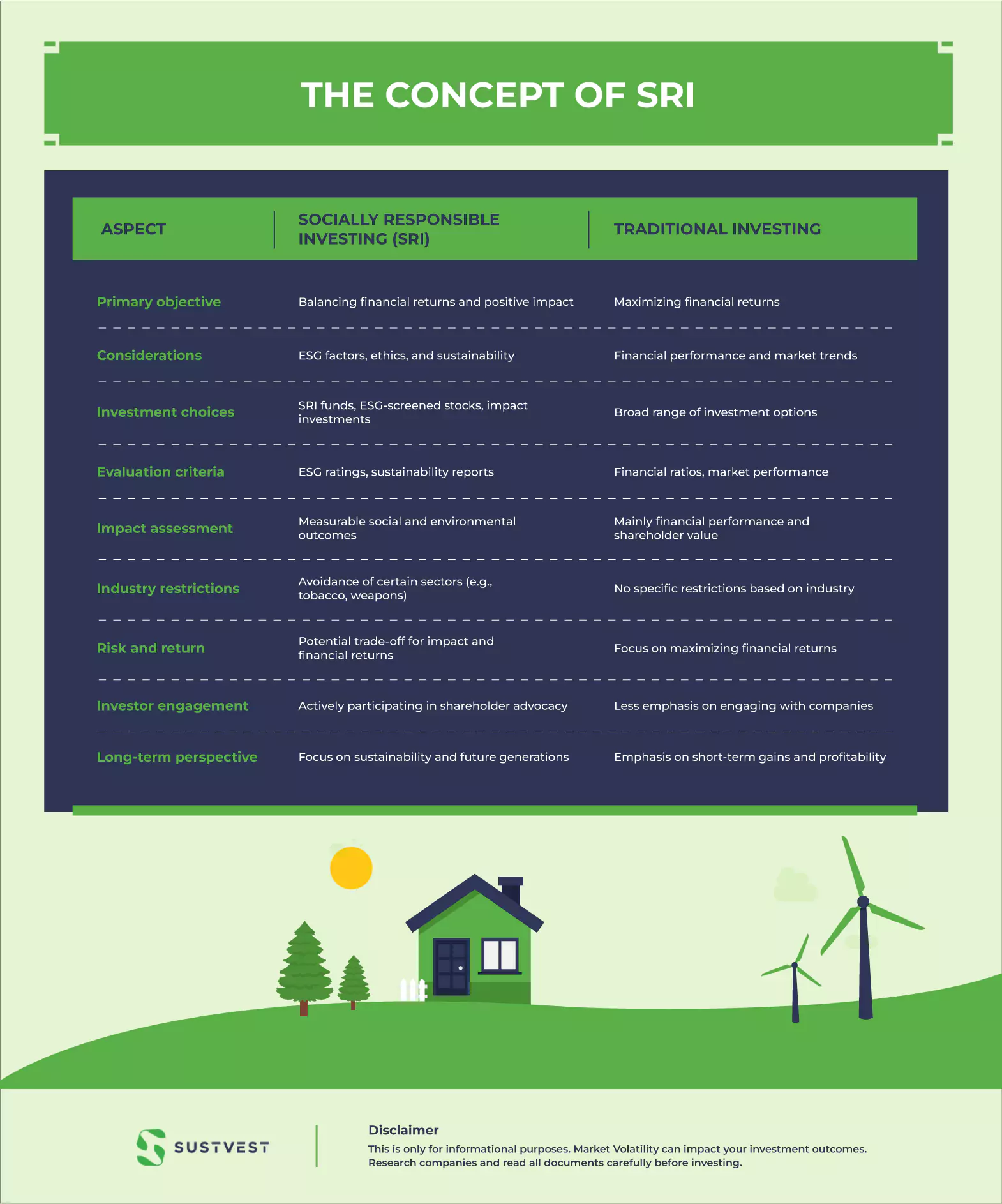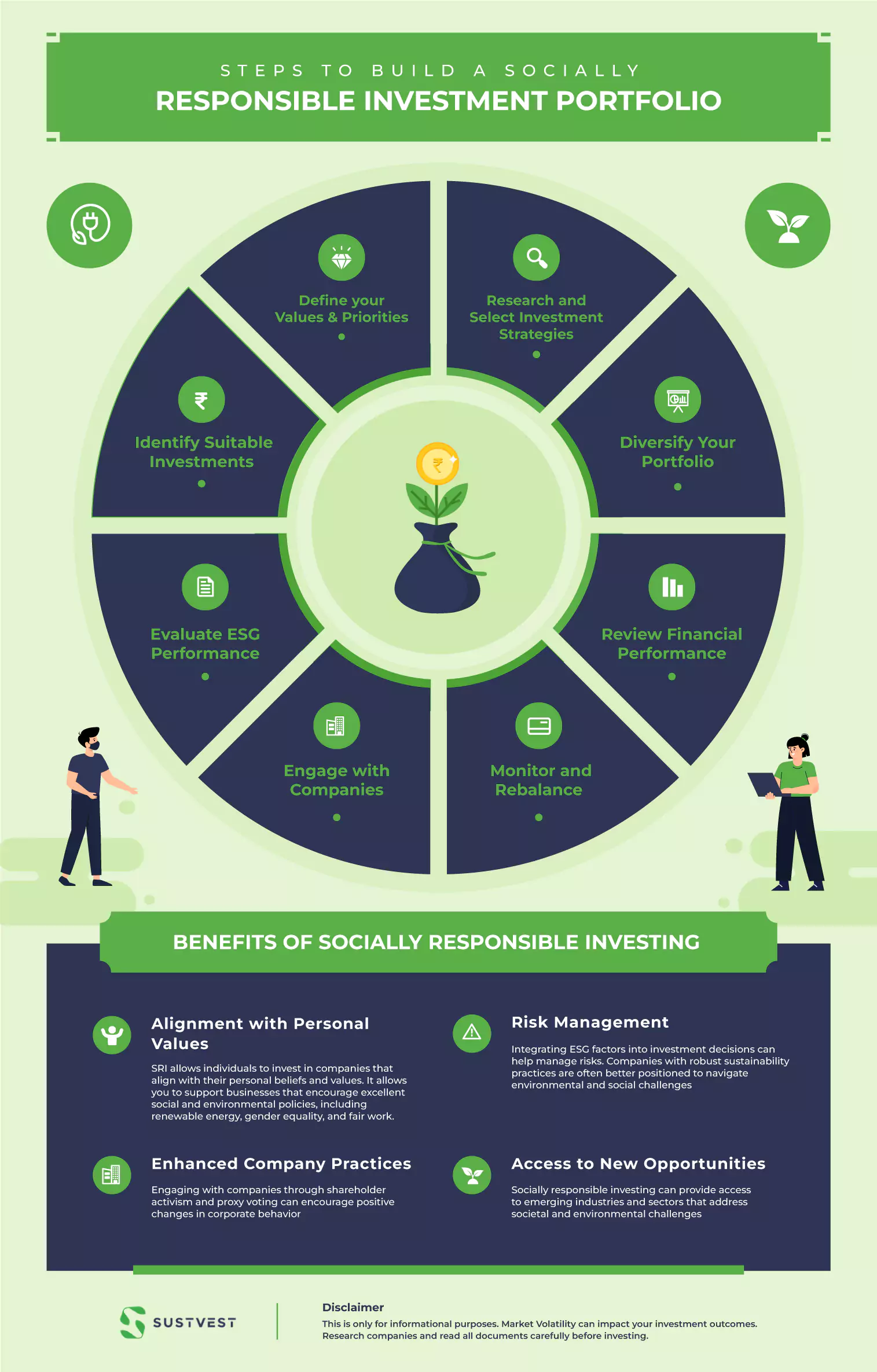Have you ever wondered how you can align your financial goals with your personal principles? In today’s fast-changing world, where social and environmental issues are taking center stage, traditional investing tactics are being reassessed. That’s where socially responsible investment portfolio (SRI) comes into play.
It’s a significant movement that allows investors to integrate environmental, social, and governance (ESG) factors into their investment decisions.
As global challenges like climate change, social inequality, and corporate governance concerns continue to gain prominence, the importance of SRI becomes increasingly evident. Investors are seeking avenues to align their portfolios with their values, promoting a more sustainable and equitable future. SRI offers an opportunity to support companies that prioritize environmental stewardship, social justice, and responsible business practices.
This article will cover socially responsible investing and how to develop a portfolio that matches an investors’ values and investment goals. We will also explore the fundamental principles of SRI, delve into the benefits it offers, and outline the steps to construct an impactful and well-diversified socially responsible investment portfolio.

The Concept of SRI
Socially responsible investing (SRI) is an investment approach that considers both financial returns and positive social or environmental impact. It involves selecting investments based on Environmental, Social, and Governance (ESG) factors.
SRI investors aim to support companies that demonstrate responsible business practices and contribute to sustainable development. This approach allows investors to align their investment decisions with their personal values and promote positive change while seeking financial gains.
Other than understanding the concept of SRI, investors must comprehend the key differences between SRI and traditional investing. This can help investors make informed decisions and align their investment portfolios with their values and sustainability goals.
Socially responsible investing differs from traditional investing in several key aspects. Here is the table summarizing the key differences:
| Aspect | Socially Responsible Investing (SRI) | Traditional Investing |
| Primary objective | Balancing financial returns and positive impact | Maximizing financial returns |
| Considerations | ESG factors, ethics, and sustainability | Financial performance and market trends |
| Investment choices | SRI funds, ESG-screened stocks, impact investments | Broad range of investment options |
| Evaluation criteria | ESG ratings, sustainability reports | Financial ratios, market performance |
| Impact assessment | Measurable social and environmental outcomes | Mainly financial performance and shareholder value |
| Industry restrictions | Avoidance of certain sectors (e.g., tobacco, weapons) | No specific restrictions based on industry |
| Risk and return | Potential trade-off for impact and financial returns | Focus on maximizing financial returns |
| Investor engagement | Actively participating in shareholder advocacy | Less emphasis on engaging with companies |
| Long-term perspective | Focus on sustainability and future generations | Emphasis on short-term gains and profitability |

Benefits of Socially Responsible Investing
Socially responsible investing involves considering environmental, social, and governance (ESG) factors when making investment decisions. Building a socially responsible investment portfolio offers several benefits, including:
- Alignment with Personal Values: SRI allows individuals to invest in companies that align with their personal beliefs and values. It allows you to support businesses that encourage excellent social and environmental policies, including renewable energy, gender equality, and fair work.
- Access to New Opportunities: Socially responsible investing can provide access to emerging industries and sectors that address societal and environmental challenges. These sectors—renewable energy, sustainable agriculture, and clean technology—have growth and innovation potential, providing financial gains.
- Enhanced Company Practices: Engaging with companies through shareholder activism and proxy voting can encourage positive changes in corporate behavior. Socially responsible investors have the opportunity to influence company practices by advocating for increased transparency, improved labor standards, reduced carbon emissions, and other sustainability initiatives.
- Risk Management: Integrating ESG factors into investment decisions can help manage risks. Companies with robust sustainability practices are often better positioned to navigate environmental and social challenges. For example, companies with strong ESG performance may be less susceptible to regulatory fines, reputational damage, or supply chain disruptions.
Steps to Build a Socially Responsible Investment Portfolio
Building a socially responsible investment portfolio involves a thoughtful and systematic approach. Here are steps to consider when constructing a socially responsible investment portfolio:
1. Define your Values and Priorities
Declare your ideals and prioritize social and environmental issues. Determine which causes or themes you want your investments to support, such as renewable energy, fair labor practices, or sustainable agriculture.
This phase ensures that your portfolio matches your values and goals and sets the framework for your investment decisions.
2. Research and Select Investment Strategies
Building a socially responsible investment portfolio requires research and selection of investment methods that match your values and interests. Consider screening techniques like negative or positive screening and explore impact investing opportunities.
Thoroughly evaluate different funds, indices, and investment products to ensure they incorporate socially responsible criteria, allowing you to make informed investment choices that contribute to positive social and environmental impact.
3. Identify Suitable Investments
Once you have chosen your investment strategy, research and identify specific investments that align with your values. Look for companies that demonstrate strong ESG performance, sustainability practices, and positive social impact.
Consider factors such as a company’s environmental footprint, labor practices, board diversity, community involvement, and ethical business conduct.
4. Diversify Your Portfolio
In building a socially responsible investment portfolio, diversification is crucial. Investors can manage risk effectively by spreading investments across different asset classes, sectors, and regions.
Diversification helps to mitigate the impact of any single investment’s performance and ensures exposure to a range of socially responsible companies.
This approach reduces vulnerability to specific industry or market risks, providing stability and potential for long-term returns in a socially conscious manner.
5. Evaluate ESG Performance
In evaluating potential investments for a socially responsible portfolio, it is essential to review the financial performance of companies.
Assess key financial indicators such as revenue growth, profitability, debt levels, and valuation metrics. Strive to find companies that demonstrate a commitment to social and environmental responsibility and exhibit financial stability and growth potential.
Balancing both social impact and financial performance is crucial for an average investment portfolio seeking to align with socially responsible values.
6. Review Financial Performance
Evaluate the financial performance of potential investments, including revenue growth, profitability, debt levels, and valuation metrics. Look for companies that demonstrate financial stability, growth potential, and strong returns.
This guarantees that your socially responsible investments correspond with your values and give competitive financial returns, helping your investment portfolio succeed over time.
7. Engage with Companies
Actively participate in shareholder engagement and proxy voting to influence positive changes in company practices. You can advocate for improved transparency, increased diversity, reduced environmental impact, and stronger social responsibility by leveraging your ownership rights.
Engaging with companies within your socially responsible investment portfolio allows you to align your values with your investment decisions and contribute to the advancement of sustainable business practices.
8. Monitor and Rebalance
Regularly review the financial and ESG performance of your socially responsible investment portfolio. Assess key financial indicators and evaluate the companies’ sustainability practices in your portfolio.
Stay informed about any changes or controversies that may impact your investments. Consider rebalancing your portfolio periodically to maintain diversification and align with your evolving values and financial goals.
Monitoring and rebalancing ensures that your portfolio remains socially responsible and aligned with your desired impact.

FAQs: What is Socially Responsible Investing, and How to Build a Portfolio in It?
What is the main objective of socially responsible investing (SRI)?
The main objective of SRI is to generate financial returns while promoting positive social and environmental outcomes.
Can socially responsible investing help address climate change?
Yes, SRI focuses on investing in companies and projects that contribute to mitigating climate change and transitioning to a low-carbon economy.
Are there financial benefits to socially responsible investing?
Yes, SRI can offer financial benefits by reducing risks associated with controversial industries, attracting socially conscious investors, and enhancing long-term company sustainability.
How can I determine if a company is socially responsible?
You can assess a company’s social responsibility by reviewing its sustainability reports, ESG ratings, and involvement in positive initiatives aligned with your values.
Can I still achieve diversification with socially responsible investing?
Yes, there are diverse socially responsible investment options available across various industries and asset classes, allowing for portfolio diversification while staying aligned with your values.
Conclusion
Socially responsible investing is a powerful tool for individuals to align their financial goals with their values and positively impact society and the environment. By following the steps outlined in this blog, readers can build a well-rounded SRI portfolio that reflects their principles and goals while generating returns.
It is essential to stay informed about SRI options, leverage resources, and engage with platforms like Sustvest. Sustvest provides comprehensive research and tools to support socially responsible investors in making informed decisions and driving meaningful change.
We can shape a sustainable and socially conscious future by harnessing the power of investing. Take the first step on your socially responsible investment journey today, armed with the knowledge and tools you’ve acquired. Let’s make a lasting impact together!

Founder of Sustvest
Hardik completed his B.Tech from BITS Pilani. Keeping the current global scenario, the growth of renewable energy in mind, and people looking for investment opportunities in mind he founded SustVest ( formerly, Solar Grid X ) in 2018. This venture led him to achieve the ‘Emerging Fintech Talent of the Year in MENA region ‘ in October 2019.




